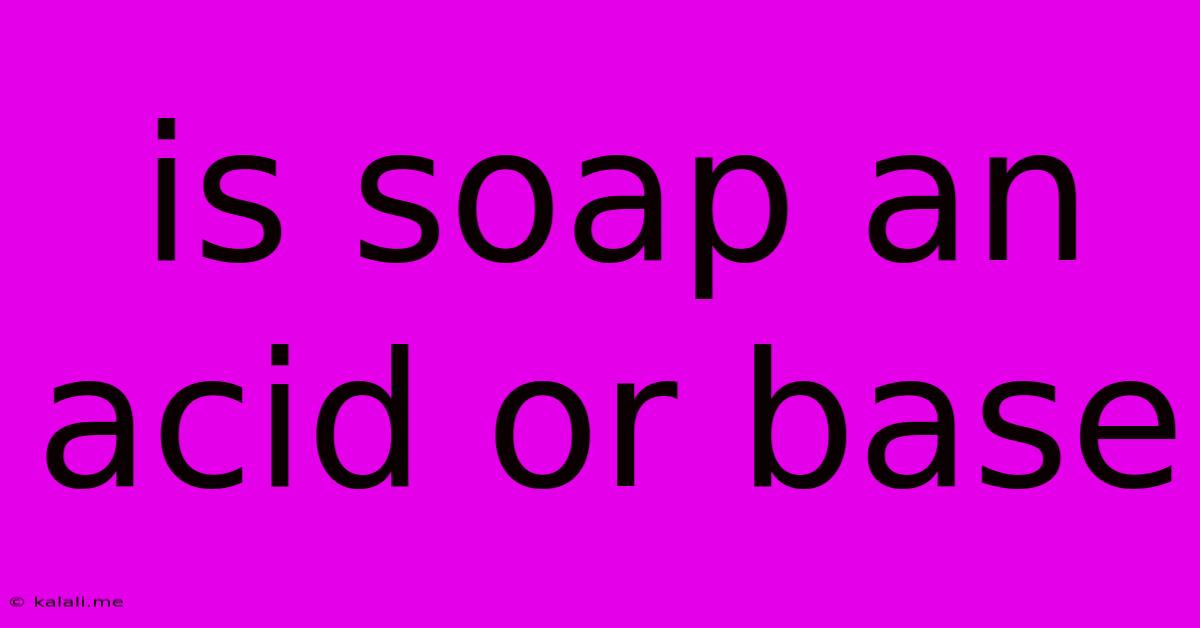Is Soap An Acid Or Base
Kalali
May 10, 2025 · 3 min read

Table of Contents
Is Soap an Acid or a Base? Understanding Soap's pH
So, is soap an acid or a base? The short answer is: soap is a base. But understanding why requires a dive into chemistry and the concept of pH. This article will explore the chemical makeup of soap, its interaction with water, and its resulting pH level, clarifying its position on the acidity-alkalinity scale. Understanding this is crucial for anyone interested in skincare, cleaning, or chemistry in general.
Soap is typically made through a process called saponification, where fats or oils react with a strong base, such as lye (sodium hydroxide or potassium hydroxide). This reaction produces glycerol and fatty acid salts – the soap molecules themselves. The presence of these fatty acid salts is what gives soap its characteristic basic nature.
The Chemistry of Soap and pH
The pH scale measures how acidic or alkaline (basic) a substance is. It ranges from 0 to 14, with 7 being neutral. Anything below 7 is acidic (like lemon juice or vinegar), and anything above 7 is alkaline or basic (like baking soda or ammonia). Soap, due to the presence of those fatty acid salts created during saponification, typically has a pH above 7, usually between 8 and 10. This means it's mildly alkaline.
Why is Soap Basic?
The alkaline nature of soap stems directly from the saponification process. The strong base used in the reaction (lye) remains present in the final soap product, albeit in a much lower concentration after neutralization. The fatty acid salts produced also contribute to the overall basicity of the mixture.
Does Soap's pH Matter?
Absolutely! The pH of soap affects its cleaning power and its potential impact on your skin. The mildly alkaline nature of soap helps to disrupt the cell membranes of bacteria and viruses, contributing to its effectiveness as a cleaning agent. However, highly alkaline soaps can be harsh on the skin, stripping away essential oils and leading to dryness, irritation, and even damage to the skin's protective barrier. This is why many modern soaps incorporate ingredients to balance the pH and make them gentler on the skin.
Different Types of Soaps and Their pH Levels
The specific pH of a soap can vary depending on several factors, including:
- The type of oil or fat used in the saponification process: Different oils yield soaps with slightly different pH values.
- The type of base used: Sodium hydroxide tends to produce harder soaps, while potassium hydroxide produces softer, more liquid soaps. The type of base can subtly influence the final pH.
- Added ingredients: The inclusion of buffers or other additives in commercially produced soaps can help to adjust the pH and make them less harsh.
Conclusion: Soap is a Base, But Not All Bases are Created Equal
In summary, soap is a base, generally ranging from pH 8 to 10. Understanding its chemical composition and the impact of its pH level is crucial for appreciating its cleaning properties and potential effects on the skin. While the slight alkalinity aids in cleaning, choosing soaps with a more balanced pH is key to maintaining healthy skin. Choosing milder soaps or those specifically formulated for sensitive skin is advisable to avoid potential irritation.
Latest Posts
Latest Posts
-
How Many Quarts In A 5 Gallon Bucket
Jul 05, 2025
-
How Far Is The Closest Ocean Beach To Me
Jul 05, 2025
-
How Long Is A China Man Joke
Jul 05, 2025
-
What Episode Does Ichigo Get His Powers Back
Jul 05, 2025
-
Pokemon Mystery Dungeon Red Rescue Team Codes
Jul 05, 2025
Related Post
Thank you for visiting our website which covers about Is Soap An Acid Or Base . We hope the information provided has been useful to you. Feel free to contact us if you have any questions or need further assistance. See you next time and don't miss to bookmark.